The concept of gears has been around for a while as they are among the oldest mechanical components that are still relevant today. Be it the automobile industry, the aerospace sector, any industrial machinery, or something simple like a clock. Gears are required everywhere and perhaps you would like to learn about gear manufacturing.
So, the question is about how gears are manufactured.
Preface: Gear Manufacturing Process
There is no single process to gear manufacturing as they require different processes depending on the type and application.
Generally, gears operate in very strenuous conditions because transmission of power (the actual purpose of the gear) has several requirements. Firstly, the gears need to be in absolutely perfect condition. Then, they must always be reliable, have minimal residual stresses, and a little to no chance of crack propagation.
Naturally, all these requirements are extremely difficult to fulfill. However, no one can deny their importance. That’s why gear production is a highly specialized field with limited tolerances and room for error.
This article will take you back to the basics of gear manufacturing concerning the common materials for industrial gears, the processes that prepare gears, and how gears can sustain all that load without failing.
Common Types of Gears and Their Applications
Before moving on to the details about gear cutting and manufacturing processes, it’s important to take a look at the basics. They are different types of gears and their application and advantages.
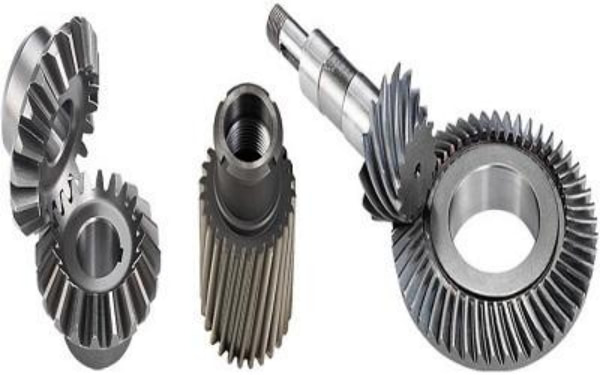
Your application, performance parameter, and numerous other factors play an important role in the kind of gears you use. There are several ways to characterize the type of gear, but the best and most relevant from a gear manufacturing perspective is through their teeth profile.
Here are the 5 kinds of gears you’ll encounter.
Spur gears
Draw a rough picture of what gear looks like in your mind. There are high chances that you are thinking of gear with straight teeth. That’s exactly what a spur gear looks like.
The spur gear is the most common type of gear and has multiple applications in powerplants, aerospace components, industrial machines, and much more. Straight teeth are the simplest to manufacture and sustain high speeds and high loads. However, they produce a lot of noise and are not suitable for applications where you need smooth operations as well.
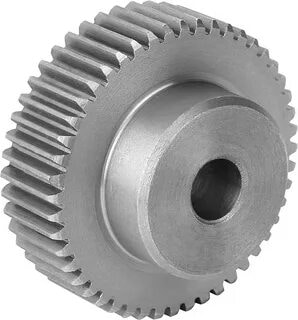
Furthermore, spur gears can mate with other gears of the same type and internal/external gears. You’ll find spur gears in many gearing mechanisms like a simple rack/pinion setup or a planetary gear system.
Their simplicity means that it’s easier for you to make. Therefore, you’ll find it easier to maintain precision during gear production. Spur gears also have little to no axial load, so they are quite efficient for a gear train where you want to minimize mechanical losses.
Helical gears
Helical gears are quite similar to spur gears but they come with teeth that are twisted around a cylindrical body. This quality allows them to work with both parallel and non-parallel shafts easily. Their mating, however, only works with other helical gears of the same helix angle (the angle of twist from the original cylinder).
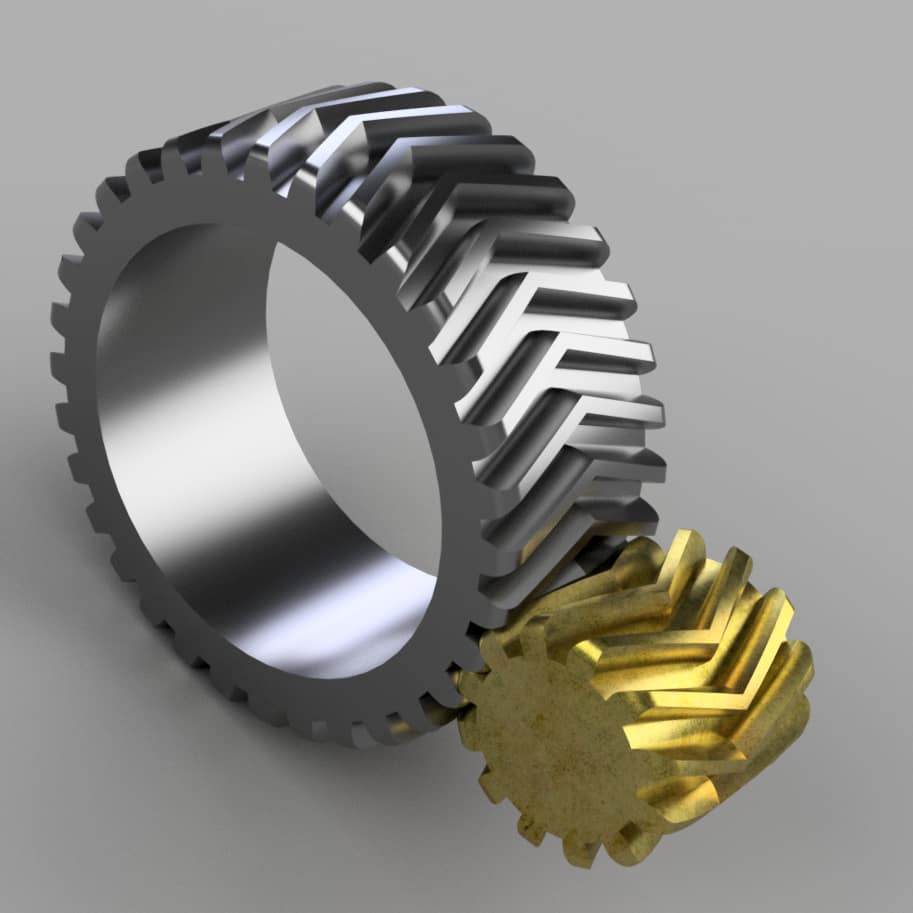
Most of the applications of helical gears are the same as spur gears. However, the angled teeth play a huge role in reducing the impact load and making the operations smoother. This means less noise as well but at the cost of efficiency. Relative to spur gears, a helical gear train will have more losses and will also need thrust bearings because of the shape.
From a manufacturing perspective, helical gears are tougher than spur gears. The helix angles are quite hard to replicate with a low acceptable tolerance range. Furthermore, the costs of manufacturing and then the addition of other axial elements make them suitable for limited operations.
Bevel gears
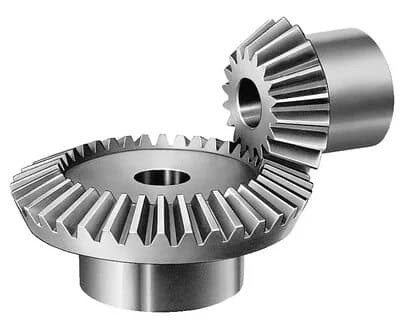
Bevel gears are not your standard cylindrical gears. They come on a conical surface that allows you to change the direction of the transmission on intersecting shafts. Generally, bevel gears work with 900 angles. However, you can use them on other configurations as well.
Here are some common types of bevel gears you can find in a variety of applications.
- Straight bevel gears
- Spiral bevel gears
- Miter gears
- Crown gears
- Hypoid gears
Worm gears
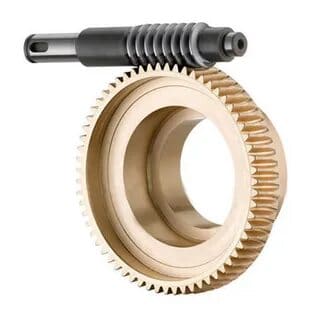
The worm gear system is a combination of two components. A worm wheel and a screw-shaped gear. They are predominantly used in aerospace, industrial machines, elevator, and automobile steering.
The worm wheel setup doesn’t offer much speed or efficiency. However, it offers a unique characteristic required for self-locking mechanisms. In many cases, the worm may turn the wheel, but vice versa can’t happen because of the gear angles. Furthermore, another important thing to note is that worm-wheel gears have a lot of friction and may require continuous friction to operate properly.
Rack and pinion
The rack and pinion system is another combination that primarily works to transfer rotational motion to linear and vice versa. The gear teeth can mate with both spur and helical type teeth, so you can work on both parallel axis and at an angle. Some of the most common applications of this system are in automobile systems, weighing scales, and other similar systems.
Materials Used to Produce Gears
There is no material restriction when it comes to gears. The earliest ones were wooden, and you can find different material gears throughout the industry. From large industrial scale gears of steel or iron to small plastic gears in toys. The material combinations are endless.
Nevertheless, the following items are most commonly used in gear manufacturing and gear forming processes:
- Cast iron
- Steel
- Bronze
- Plastics
Gears have very specific criteria for material selection. Depending on the application, whatever material you choose should have the appropriate tensile strength and endurance.
Additionally, the coefficient of friction is another consideration because gears need constant contact. Finally, you should also select materials that are easy to process. A strong material with low manufacturability will be harder to deal with because gears manufacturing requires extreme precision and accuracy.
The aforementioned materials come with the perfect balance of these properties for their applications. That’s why you’ll commonly see them in most gears you come across.
RapidDirect can offer all these materials used in the gear manufacturing process. Upload your design file to get a quotation for your gear project.
Common Gear Manufacturing Processes
Gear production is quite complicated because of the precision it demands. Today, gear manufacturing is an industry in itself that relies on multiple processes, both traditional and modern, to ensure the right balance between cost, quality, and operations.
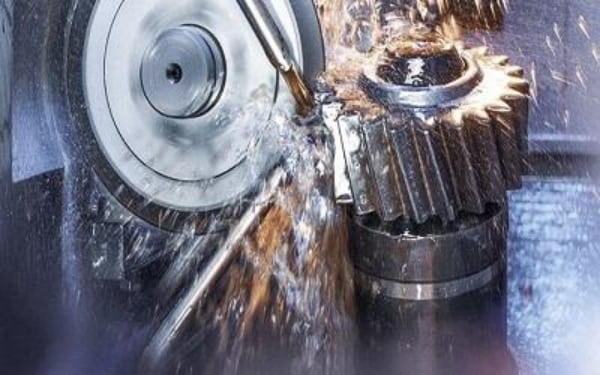
Here’s a list of common gear cutting and manufacturing processes along with their apparent advantages and disadvantages.
1 – Casting
Casting is a simpler process that is predominantly used to prepare blanks or cylinders for gears, while the teeth are prepared through machining. However, it’s a viable gear manufacturing process for the whole thing for many applications because of its mass production capability and relative ease.
There is, however, one area where casting is the most preferred manufacturing method in the industry. That is the production of very large gears. Machining methods and other gear forming methods are not that viable in cases of large diameters. Generally, larger gears are almost always of spur gear type. So, their relative simplicity makes casting a very good option.
Among the most common types of casting methods, shell casting, die casting, sand casting and permanent mold casting are the most common for gear production. Other methods have limited use in some applications. However, the aforementioned are the most common in the industry.
2 – Forging
This is another forming process that can give you both blanks and prepared gears depending on your requirements. Forging is quite viable in cases where you have relatively simple gears.
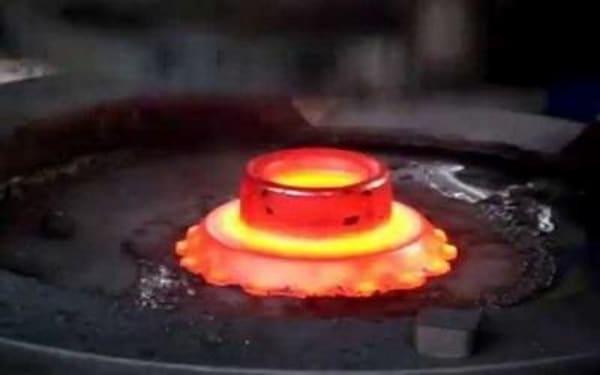
Theoretically, forging is an excellent gear manufacturing process for heavy-duty applications because of a simple reason. Forging requires heat treatment, which means that the resulting gear would have better fatigue properties. However, the tremendous force required for the forging process limits the size and thinness of this process.
Generally, forging works well for gears within 6 – 10 ft diameter gears. Depending on the type of forging for example precision forging, you may or may not need to machine the gears in the end.
3 – Extrusion and cold-drawing
This is another gear-forming process that’s both versatile and simpler. In fact, extrusion has a lower tool expenditure but it doesn’t mean that it’s the most economical process.
Extrusion, as its name suggests, is the process of passing a heated metal profile through a smaller pre-determined shape. Resultingly, you get a bar of your desired shape with a hardened and smooth outer surface.
The cold drawing process is very similar to extrusion. There are two differences. Extrusion pushes the blank through a die drawing pulls it. The other difference is the temperature. Cold drawing doesn’t heat the billet. Thereby increasing the mechanical properties at the expense of cost.
4 – Powder metallurgy
Powder metallurgy is an advanced process that made significant advancements in recent years. Today, it’s used for multiple manufacturing processes including gear production.
So, how does powder metallurgy works? From the outlook, it’s quite simple. However, there are many intricacies involved.
It all starts with metal powder. The first step is to take all the powder is give it a finalized form that you desire. Once you are done, the next step ensures that the entire setup is quite compact as it will result in better mechanical properties. Heat the entire setup carefully and you are done.
Powder metallurgy is extremely efficient, simple, and viable for large quantities. You don’t have to worry about any post-processing as well as the product will be ready to use. However, the resulting gears can’t bear too much load and there are size limitations as well.
Moreover, the initial cost for any powder metallurgy setup is quite high, which makes it unviable for any low-volume production.
5 – Blanking
Blanking is a very similar process to extrusion but has limited 3-dimensional capabilities. This gear forming process uses sheet metal to create the desired shape with the help of multiple dies. You can produce different types of gears with the blanking process. However, spur gears give you the best results.
Today, the blanking process of gear production is used by multiple industries for lightweight applications. For example, office equipment, hydraulics, small medical devices, and other applications with low load requirements.
6 – Gear Machining
Machining is among the most common gear manufacturing processes because of its versatility. Traditional machining was quite common for gear cutting and manufacturing but the advancements of CNC machining have propelled its popularity.
The following 4 gear cutting methods are the most common across the industry.
Hobbing
Hobbing utilizes a conical cutting device called a hob. Both the hob and the workpiece turn as the hob rotates around the gear blank. So far, external spur and helical gears are the only products you can create from hobbing.
The process is quite versatile and quick. You can also increase your production rates by processing multiple stacks together. However, it requires more skills and precision.
Shaping
Shaping is an advanced gear cutting and manufacturing process that develops gears that Hobbing can’t handle. The cutter can be of any shape like a pinion, rack-shape, or single-point shape. It looks quite similar to gears and works by cutting into the blank at your required shape. You can create internal or cluster gears with the shaping process.
Broaching
Broaching is perhaps the quickest method of gear form-cutting. It relies on a multi-teeth tool with embedded cutters that go deeper than their predecessor. This results in smaller, incremental cuts that are easier to make and quickly give you the required shape without compromising the precision.
This gear manufacturing process is typical for internal gears but you can use it to make external teeth as well. For that, you’ll need a specialized tool for pot broaching that allows you to replicate the same precision and efficiency.
Milling
This is a basic gear cutting method where you produce individual gear teeth sequentially. It is however quite versatile, especially when you involve a CNC milling machine. While you can make any type of gear on a milling machine, the precision of this method leaves a lot to be desired. That’s why milling is not as common as it was before.
However, the recent developments in the CNC domain and multi-axis have changed things. Gear manufacturing on milling machines is becoming more and more common. So, things will get even better with time.
Gear Manufacturing Post-processing
Depending on the gear manufacturing method you used, your gears will need some post-processing before they are 100% ready. That post-processing can range from heat treatment for improved fatigue characteristics to dimensional correction and surface finishing.
Here are the 5 most common surface finishing processes that are common in gear production.
- Grinding: Just as its name suggests, grinding is a common surface finishing process that gives you a smooth finish throughout the surface. You can perform it intermittently or continuously, and it won’t affect the results.
- Lapping: This process is for sensitive gears where you need extreme precision. Lapping uses small abrasive particles to smooth out a surface at low or medium speeds.
- Honing: This is another common process that polishes the surface and makes it smooth. Moreover, you can also correct some minor errors in your tooth geometry.
- Shaving: This process removes extremely thin layers from the surface to achieve a smooth profile. Shaving is generally expensive, so it’s rarely used in gear production.
- Burnishing: In its essence, burnishing is the process of using compression to smooth out the surface.
Approach RapidDirect for the Best Gear Manufacturing Services
Gear manufacturing is a highly specialized field that requires extreme precision and accuracy. Gears are an essential component for any mechanical system and even the smallest manufacturing flaw can have a lot of disastrous consequences. Therefore, you need to be careful about the service you select.
RapidDirect is an ISO-certified service with the most experienced team that delivers the best performance at the most competitive price. We offer state-of-the-art services that deliver you the best when it comes to gear manufacturing.
From large gears for industrial machinery to the smallest components for any niche application, RapidDirect offers the right combination of skills, experience, and quality you need. Contact us today and get an initial quote within a few hours.


